Since I was a young child Mars held a special fascination for me. It was so close and yet so faraway. I have never doubted that it once had advanced life and still has remnants of that life now. I am a dedicated member of the Mars Society,Norcal Mars Society National Space Society, Planetary Society, And the SETI Institute. I am a supporter of Explore Mars, Inc. I'm a great admirer of Elon Musk and SpaceX. I have a strong feeling that Space X will send a human to Mars first.
Thursday, June 29, 2023
Wednesday, June 28, 2023
A Veteran Astronaut Adjusts To A New Era Of Private Space Flight
 Peggy Whitson spent 665 days in space on three long-duration ISS missions before a much shorter visit in May commanding the Ax-2 private astronaut mission. (credit: Axiom Space) |
A veteran astronaut adjusts to a new era of private spaceflight
by Jeff Foust
Monday, June 26, 2023
Peggy Whitson is America’s most experienced astronaut, having spent 665 days in space on three long-duration missions to the International Space Station in 2002, 2008, and 2016–2017. But returning to the station as a private astronaut, commanding Axiom Space’s Ax-2 mission in May, still required some adjustments.
“The short time was the harder part,” she said of the mission, which spent eight days docked to the ISS, during an interview a couple weeks after splashing down in a Crew Dragon spacecraft with her three crewmates May 30.
| “The big change really is to go back to short-duration missions, more like a shuttle flight,” she said of training for Ax-2. |
“When you go up on a long- duration mission you are thinking, I’ve got time, I can relax now, because I can scale up and start moving later and getting more and more done,” she explained. “But we didn’t have that flexibility. It was very much a focused effort.”
Ax-2 was Axiom’s second in a series of private astronaut missions to the station as the company develops commercial modules to install on the station later this decade, which will later form the core of a standalone commercial station. Ax-1, which went to the station in April 2022, was something of a learning experience for both the company and the agency, particularly in how to schedule all the experiments and outreach activities the crew wanted to achieve.
One of the biggest lessons was optimizing the training for the mission. “The big change really is to go back to short-duration missions, more like a shuttle flight,” she said. “Instead of generic skills training, which is typically how we train a station crew, we were much more task oriented. So, we focused on the tasks we knew we would do and the hardware we knew we’d interface with. That made our crew ready to respond and ready to perform once they got on orbit.”
While Ax-1 got some schedule relief when its ten-day mission was extended a week while waiting for favorable splashdown conditions, Ax-2 had its mission shortened from ten to eight days because of the cascading effects of launch delays and a desire by NASA to keep a cargo Dragon mission on schedule for launch in early June.
“It was a compressed schedule,” she said, but the focus on specific training helped accommodate that time, along with keeping her schedule open in the early days of the mission to assist her crewmates, helped. “I think it was very effective.”
Whitson had been training with John Shoffner, a private astronaut who served as pilot of Ax-2, since 2021, when the two were named as backups for Ax-1. Shoffner used that time to get extra training on ISS systems, including getting a specialist rating—the highest NASA qualification—on station maintenance. “He wanted more of the experience of what it is like to train as a NASA astronaut,” she said, “so we were able to get him that extra training.”
They started training with the other two Ax-2 crew, Saudi astronauts Ali Alqarni and Rayyanah Barnawi, in September. In addition to various training on ISS and Crew Dragon systems, they also did an exercise with the National Outdoor Leadership School, learning what she called “expeditionary skills” in the wilderness, and spent time in the Human Exploration Research Analog (HERA), a simulated space habitat at the Johnson Space Center.
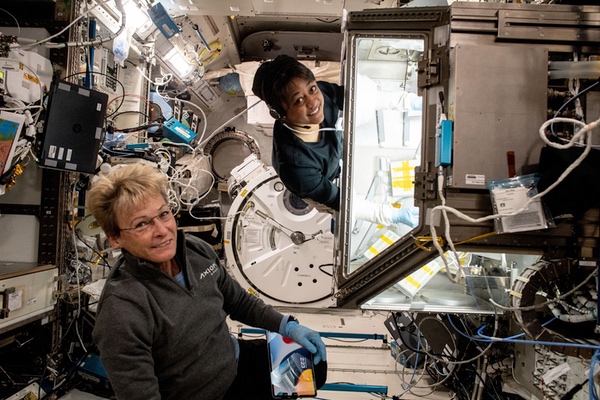 Peggy Whitson and Rayyanah Barnawi doing research on the ISS during Ax-2. (credit: Axiom Space) |
The training overall went well, Whitson said, and her crewmates adapted well to the station and the research programs. She singled out Barnawi, a cancer researcher, for her dedication to doing experiments in a “glovebox” on the station, spending so much time that others were worried about her.
“I go check on her and I’m like, ‘Everybody’s really worried about you and I want to know how you are feeling about being in here?’ She’s loving it,” she recalled. “I’m basically having to fight her to get her out of there so I could get in there.”
| “It was a lot of fun to fly on a new vehicle,” she said. “The Falcon 9 and the Dragon was a sweet ride.” |
There are lessons learned and other adjustments to training she wants to incorporate on future Axiom missions to the station. “I want to try and so some more intensive mission-specific training,” she said. The five days the Ax-2 crew spent in HERA was particularly useful, she said, given them experience in a simulated space environment, including learning how to work to a timeline and communicate with controllers.
Visiting the ISS as a private astronaut for the first time, after extended stays as a NASA astronaut, was not as big a change for Whitson as the short mission duration. She compared it to visiting shuttle crews during her earlier long-duration stays there. “It felt familiar in that sense. I was just in the other the other side of it. I was the visiting crew rather than the resident crew.”
The Ax-2 crew got along well with the long-duration station crew. Whitson said they had not gotten a chance to meet with NASA’s Frank Rubio and Roscosmos’ Sergey Prokopyev and Dmitri Petelin before the flight, since the three had been scheduled to return in March before Ax-2. A coolant leak in their Soyuz spacecraft, though, prompted the launch of a replacement that had been intended for the next crew, keeping the three of them on the station until September. “Frank’s an amazing leader and they all have a pretty good attitude about being there an extra six months,” she said.
Whitson, who previously went to the station on shuttle and Soyuz vehicles, enjoying flying Crew Dragon. “It was a lot of fun to fly on a new vehicle,” she said. “The Falcon 9 and the Dragon was a sweet ride.”
A highlight of the Crew Dragon is the touchscreen interface. “It’s very integrated with procedures and data. It feels like you’re very situationally aware as you’re going through the steps and performing actions,” she said. “I find it’s a great interface, much more operator friendly, user friendly for the astronauts.”
Splashing down in the ocean, she added, was also better than the Soyuz landings. “But the shuttle landings on runways is the best way to come home.”
| “Now I think we’ve demonstrated that we’ve got this,” she said. |
Whitson estimated that Axiom incorporated about 80% of the lessons learned from Ax-1 into Ax-2, with the remaining 20% to be worked into Ax-3, currently scheduled for no earlier than late this year. Axiom has not announced the crew for that mission but, during the webcast of the Ax-2 splashdown, the hosts said that Michael López-Alegría, who commanded Ax-1, would lead Ax-3.
Those training plans will shift again the coming years as Axiom gets its modules installed on the ISS—the first is scheduled for launch as soon as late 2025—and goes towards longer missions. “But I think that to make us successful now we need to really push back toward that short mission and optimize it,” she argued.
“Now I think we’ve demonstrated that we’ve got this,” she said. “The next phase is going to be the continuation and expansion of this.”
Jeff Foust (jeff@thespacereview.com) is the editor and publisher of The Space Review, and a senior staff writer with SpaceNews. He also operates the Spacetoday.net web site. Views and opinions expressed in this article are those of the author alone.
Tuesday, June 27, 2023
Book Review-Under Alien Skies
 |
Review: Under Alien Skies
by Jeff Foust
Monday, June 26, 2023
Under Alien Skies: A Sightseer’s Guide to the Universe
By Phil Plait
W. W. Norton & Company, 2023
hardcover, 336 pp., illus.
ISBN 978-0-393-86730-5
US$30.00
Astronomers provided a bit of disappointing news last week about an exoplanet. Observations of TRAPPIST-1 c, one of seven planets known to orbit a red dwarf star, led astronomers to conclude the Earth-sized planet either has a tenuous atmosphere of carbon dioxide or no atmosphere at all. Before the James Webb Space Telescope observations, astronomers suspected the planet, while unlikely to be habitable, might have a dense Venus-like atmosphere. That could mean more distant planets could also lack atmospheres, if they formed in the same environment.
The TRAPPIST-1 system is one of the destinations in Under Alien Skies by Phil Plait, an astronomer and science communicator widely known as the “Bad Astronomer.” Plait takes the reader on a fascinating tour of the solar system and beyond, using destinations from the Moon to black holes to enlighten readers about aspects of astronomy and planetary science.
| Plait writes in a fun, accessible style (“We humans are gloppy bags of meat, and we need water to live,” he writes on the importance of finding water ice on the Moon) but there is plenty to learn. |
The use of “tour” above is more than a figure of speech: Plait structures the book as through the reader was visiting these worlds, watching a solar eclipse from the Moon or looking up at Saturn’s rings from its atmosphere (hence the “under alien skies” of its title.) That allows him to explore what we know about a variety of destinations in the solar system and galaxy. The chapter about the Moon, for example, discusses topics from lunar phases to the potential for ice at the lunar poles and the using the lunar farside for radio astronomy, shielded from the Earth’s radio chatter.
Plait writes in a fun, accessible style (“We humans are gloppy bags of meat, and we need water to live,” he writes on the importance of finding water ice on the Moon) but there is plenty to learn even for those familiar with much of the science in the book, thanks to his attention to detail. For example, on those TRAPPIST-1 worlds, 40 light-years from Earth, the positions of stars will have shifted enough to alter familiar constellations like Orion, “distorting the constellation severely while keeping it more or less recognizable.”
Some of the destinations mentioned in the book may be visited relatively soon by people: within a decade humans should be on the Moon, perhaps taking in familiar eclipses from unfamiliar vantage points. Humans may be on Mars in a few decades, and possibly on asteroids in similar time frames. But Saturn and Pluto, two other worlds in our solar system mentioned in the book, are likely beyond the reach of any readers of the book currently alive, and TRAPPIST-1 and beyond may always be out of reach. But the descriptions he provides of floating in Saturn’s atmosphere in a balloon, looking up at the rings, is fascinating enough to make you want to start saving up for a trip, just in case.
Jeff Foust (jeff@thespacereview.com) is the editor and publisher of The Space Review, and a senior staff writer with SpaceNews. He also operates the Spacetoday.net web site. Views and opinions expressed in this article are those of the author alone.
Note: we are using a new commenting system, which may require you to create a new account.
Monday, June 26, 2023
Saturday, June 24, 2023
Wednesday, June 21, 2023
The NASA Budget Is Going To Be In For A Rough Ride!!!
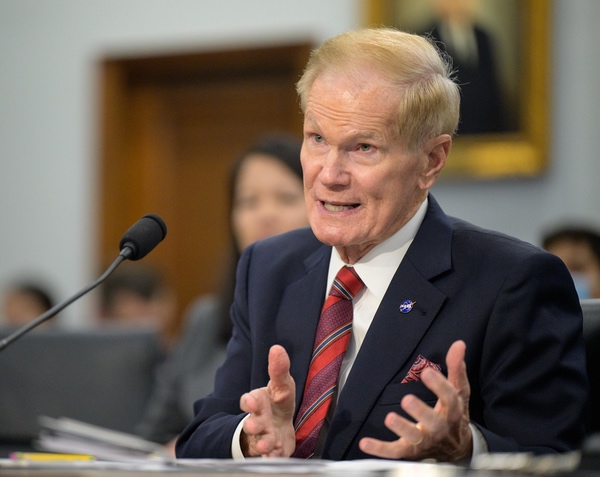 NASA administrator Bill Nelson made his case for the agency’s 2024 budget proposal to House appropriators in April, who are now considering significant cuts in their spending bills. (credit: NASA/Bill Ingalls) |
A chaotic trajectory for NASA’s budget
by Jeff Foust
Monday, June 19, 2023
The federal appropriations process is never easy, but some years are more difficult than others. This year appears to be shaping up to be one of the more difficult ones, particularly for NASA.
That process started in March with the release of the president’s budget proposal for fiscal year 2024. There were few surprises in that proposal, with the only new major project seeking funding is a deorbit vehicle for the International Space Station: $180 million in 2024 for a vehicle that agency officials said might cost up to $1 billion, all to provide redundancy for Russian Progress cargo spacecraft to ensure a safe deorbiting of the station around 2030.
The budget proposal sought an overall increase of 7.1% for NASA to $27.2 billion. While at first glance that might look a healthy increase, it was only roughly keeping pace with inflation over the last year.
| One scenario that saw NASA’s budget cut by 22% from 2023 levels “would have devastating and potentially unrecoverable impacts,” Nelson warned. |
Budget proposals are just that: proposals that are often substantially altered by Congress. (If you had a dollar for every time someone says, “The president proposes but Congress disposes,” you could fund NASA for a substantial part of next year.) That process plays out over months in the House and Senate.
However, it was clear early on that there would be problems, not for NASA specifically but for the overall appropriations process. The new Republican leadership of the House, expressing concerns about large budget deficits, said they would only agree to an increase in the debt ceiling, needed by June, if it was also accompanied by caps that could cut spending on discretionary programs, like NASA.
How much of a cut was not clear from those initial proposals. However, Democrats on the House Appropriations Committee asked agencies to outline the potential effects in two scenarios. In one, overall discretionary spending, both defense and non-defense, was reduced to 2022 levels. In the other, overall discretionary spending was reduced to 2022 levels but the cuts concentrated on non-defense agencies.
In his response, NASA administrator Bill Nelson warned of dire consequences in either scenario. In the first, NASA’s budget would drop to $24 billion. That would delay several planetary science missions already facing budget and schedule problems (see “The hard truths of NASA’s planetary program”, The Space Review, March 20, 2023) as well as other Earth and space science missions. NASA would delay work on that ISS deorbit tug and slow down funding for commercial space stations to succeed the ISS. It would also “substantially delay” Artemis 4 and end work on contracts to support later Artemis missions.
In the second scenario, NASA’s budget would fall to $19.8 billion, 22% below its 2023 level. Many of the science missions facing delays in the first scenario would now be in danger of cancellation, NASA argued. There would be a “substantially increased risk to U.S. presence” in low Earth orbit by delaying the deorbit tug and commercial space station work while also cutting back on cargo flights to the ISS. The cuts would also threaten Artemis 4 and “defer lunar exploration beyond Artemis IV.”
“To fund NASA at such a level in FY 2024 would have devastating and potentially unrecoverable impacts,” Nelson said of the latter, more severe scenario in his letter to House Democrats.
Even as the bigger debates about spending caps continued between House Republicans and the White House, NASA’s budget pressures only got worse. Appearing before Senate appropriators April 18, Nelson said he was informed that the Mars Sample Return (MSR) effort needed more funding than what was in the request for 2024, or even what was provided in 2023.
“I was just out there,” Nelson said of a visit to JPL, the lead center for Mars Sample Return, “and they’re saying they want an additional $250 million in this year—meaning in this year, existing, 2023—and 2024.” He didn’t elaborate on what prompted that increase, and the agency has not been forthcoming since that testimony on potential cost increases, noting that MSR is still working towards a review this fall that will set a formal cost and schedule.
Nelson was also forced to defend, at both that Senate hearing and one the next day by House appropriators, a potential cut in the Dragonfly mission to Saturn’s moon Titan. Nelson said that the mission was still on schedule for a 2027 launch, although project officials later said they were evaluating the effects of the proposed cut on the mission.
During the Senate hearing, Nelson stated several times that, despite a record budget of $8.26 billion for science proposed for the agency for 2024, tough decisions about missions were necessary. “In the largest science budget ever, you can’t fit 10 pounds of potatoes in a five-pound sack,” he said.
That 2024 request assumed a spending increase that looked doubtful amid the debt ceiling debate. “A 22% cut or a continuing resolution that would leave the funding at the ’23 level would cause a slowdown of programs at NASA across the board,” Nelson warned House appropriators.
| “In the largest science budget ever, you can’t fit 10 pounds of potatoes in a five-pound sack,” Nelson said. |
Those debt ceiling negotiations—conducted under the threat of a government default in early June if there was no deal—concluded with an agreement over Memorial Day weekend. In exchange for suspending the debt ceiling through 2024, non-defense discretionary spending would be held at 2023 levels for fiscal year 2024 and increased 1% for 2025. It was a reduction in real spending power when accounting for inflation, but far less than the worst-case scenarios from the spring.
The caps are not across-the-board measures: appropriators can increase or decrease spending for individual agencies or departments, and their individual programs, within those caps. However, NASA officials now recognize that the 7% increase they requested for 2024 seems unlikely.
“We do have to face the reality of the debt limit ceiling agreement and what might happen to our 2024 budget request,” Pam Melroy, NASA deputy administrator, said at a June 7 meeting of the National Academies’ Aeronautics and Space Engineering Board and Space Studies Board. “We recognize that it’s unlikely we will get the full request, and we know that’s going to create challenges for us in the future.”
She didn’t elaborate on the specific challenges, beyond stating that NASA will have “some hard decisions this year.”
Other NASA officials echoed those sentiments. “What we would cut now, I couldn’t tell you,” Ken Bowersox, NASA associate administrator for space operations, said at a Space Transportation Association event June 8.
That uncertainty stems from the fact that House and Senate appropriators have not started work on most of their spending bills, including the commerce, justice and science (CJS) one that funds NASA. Only last week did House appropriators approve how much money would be available for each of the dozen spending bills they will consider, known as 302(b) allocations.
That House decision, though, might cause NASA to dust off those worst-case scenarios from the spring. Rather than approve allocations for non-defense spending bills that, in sum, would be the same as for 2023, the Republican-led committee opted for significantly lower allocations for many of those bills.
“While the Fiscal Responsibility Act set the topline spending limit, it does not require that we mark up our bills to that level,” Rep. Kay Granger (R-TX), chair of the committee, said in an opening statement at the June 14 hearing, referring to the bill that raised the debt ceiling and enacted spending caps. “Simply put, the debt ceiling bill set a ceiling, not a floor, for fiscal year 2024 bills.”
Those 302(b) allocations, approved by the committee on a party-line vote, would provide $58.7 billion for the overall CJS bill, 28% less than 2023 spending. There is no insight into how that might be distributed among the various agencies included in the bill, but it is hard to imagine a scenario where NASA does suffer significant reductions to some of its programs.
| The only thing certain for the next several months is that NASA is unlikely to get all that it asked for in 2024, or even possibly all that it got in 2023. |
That said, there is still months to go in the appropriations process. Some Republican members of the committee have claimed that “clawbacks” of spending elsewhere, such as unspent pandemic relief aid, that was part of the Fiscal Responsibility Act might offset some of those cuts, but they have not provided details. Appropriators have not announced when they will take up a version of the CJS spending bill.
The Senate Appropriations Committee is scheduled to approve its 302(b) allocations later in the week, and the Democratic-led committee is expected to stick close to the spending cap level. That will make reconciling the House and Senate spending bills challenging, to say the least.
In the past, such a scenario might end up being resolved with a year-long continuing resolution holding funding at 2023 levels. Given that would be close to the best-case scenario for many agencies, though, there’s a risk a divided Congress might not be able to pass that, prompting a government shutdown until one side or the other yielded.
The only thing certain for the next several months is that NASA is unlikely to get all that it asked for in 2024, or even possibly all that it got in 2023. The questions will be what parts of the agency bear the brunt of any reductions and how that will affect priorities ranging from returning humans to the Moon to studying the rest of the universe, as well as our own planet.
Jeff Foust (jeff@thespacereview.com) is the editor and publisher of The Space Review, and a senior staff writer with SpaceNews. He also operates the Spacetoday.net web site. Views and opinions expressed in this article are those of the author alone.
Note: we are using a new commenting system, which may require you to create a new account.
The Implications Of The UK's National Space Strategy On Special Operations
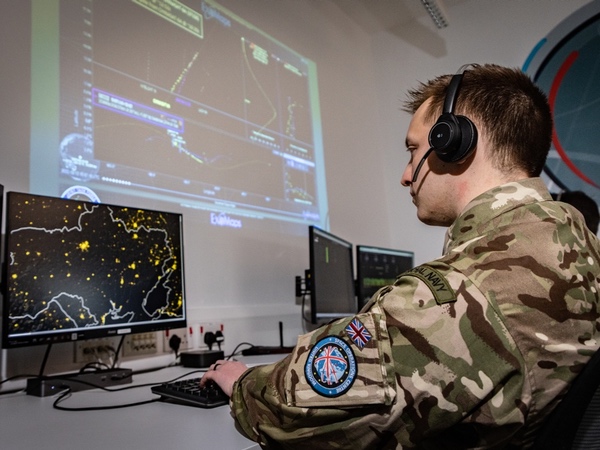 The United Kingdom is focusing more on both civil and military space, including establishing a UK Space Command. (credit: UK Space Command) |
The implications of the UK’s National Space Strategy on special operations
by Jack Sharpe, Fotios Moustakis, Markos Trichas, and Damian Terrill
Monday, June 19, 2023
Space capabilities have become an integral part of our daily lives, yet their significance often goes unnoticed by many. While space has captivated generations and driven nations to push technological boundaries, it remains an unsung enabler of modern life. The National Space Strategy (NSS) of the British Government is a testament to the criticality and potential opportunities presented by space. This document positions Great Britain as a pioneering force within the international spacefaring community, showcasing the UK government’s commitment to space exploration, technology, and research. However, the NSS falls short in terms of signaling increased capital expenditure, setting concrete milestones, and establishing realistic outcomes. This article will discuss the NSS, its potential impacts for UK special operations, and why UK Defence must integrate space with special operations planning and activity.
What is in the NSS and what is missing
The NSS outlines four distinct phases in its journey: the countdown phase, the ignition phase, the thrust phase, and the orbit phase. While it can be argued that the first two phases have already passed, we are currently transitioning into the thrust phase, which spans from 2023 to 2030. As Bill Gates (1996) astutely observed, humanity tends to overestimate what can be achieved in the short term but underestimates what can be accomplished in the long term. Consequently, it is imperative that the NSS undergoes periodic reviews to ensure its relevance and effectiveness.
| This document positions Great Britain as a pioneering force within the international spacefaring community… However, the NSS falls short in terms of signaling increased capital expenditure, setting concrete milestones, and establishing realistic outcomes. |
Despite its nuanced messaging, the NSS underscores significant threats within the space domain. The strategy places great emphasis on great power competition, which directly affects Great Britain’s security. As the number of state and commercially operated space objects continues to rise, space is becoming increasingly congested and contested (Marones & Nones, 2022). Consequently, states compete for limited resources and often employ cunning methods to undermine their adversaries’ access to space.
Miscalculations in the space domain can undoubtedly lead to escalation and potential hostilities (Harrison et al., 2017). The NSS endeavors to mitigate this risk by enhancing Great Britain’s global influence and diplomacy (HMG, 2021). By setting a global example and rallying the United Nations and other space-governing agencies, Great Britain aims to discourage the weaponization of space (Defence Space Strategy: Operationalising the Space Domain, 2022).
It is important to note, however, that space is already militarized, meaning it is used for military purposes, although it is not openly weaponized, with weapons platforms stationed in space (Zwart & Henderson, 2021). Furthermore, the Outer Space Treaty (UNOOSA, 1966) does not prohibit the placement of conventional weapons in space; it only prohibits weapons of mass destruction. Agreed norms of behavior in space typically focus on preventing the proliferation or development of weaponry. This is exemplified by initiatives pursued by Russia and China, such as the Prevention of an Arms Race in Outer Space (PAROS) (NTI, 2022).
Similarly, Great Britain has outlined plans for the development and procurement of space capabilities for military purposes (Defence Space Strategy: Operationalising the Space Domain, 2022), indicating a national interest in the militarization of space. Whether this interest pertains to Earth observation (EO) and intelligence gathering, missile launch detection, or enabling precision-guided munitions (PGM) remains undisclosed. The weaponization of space is an intriguing subject, as it could provide significant advantages over adversaries lacking access to space weapons. However, it could also be argued that such actions violate the Outer Space Treaty. Nevertheless, it is plausible that these capabilities are being explored, despite states’ apparent opposition to deploying weapons in outer space.
The NSS consistently highlights collaboration and coherence as essential elements for success in space. By encouraging investment, fostering partnerships, establishing bilateral relationships, and promoting systematic concurrence, Great Britain aims to align nations sharing similar global values. The UK-Australia space bridge serves as an exemplar of this approach (“‘Space Bridge’ Across the World,” 2021). This partnership facilitates trade, investment, and collaboration between the two nations, strengthening ties and creating opportunities for bilateral agreements on the global stage. Additionally, it enhances the collective ability of both countries to compete with other powerful states (US Department of State, 2022). As the West pivots toward the Indo-Pacific and engages in regional power competition with the People’s Republic of China (PRC), such partnerships become increasingly relevant (Gilday, 2022; “The Integrated Review of Security,” 2021). Space is a domain of warfare and political influence and will remain integral to terrestrial diplomacy. Neglecting space will put any nation at a disadvantage.
While the NSS discusses an end-to-end approach to space, it does not provide a definitive plan for delivering its various components. The governance and security of space assets must address challenging areas such as the protection of people, processes, technologies, and information (confidentiality, integrity, and availability). Ensuring the security of our people, talent, technology, and information is of utmost importance. Stricter regulations regarding foreign trade and cybersecurity standards for space assets must be considered. The notion put forward by Pavur and Martinovic (2022) that satellites maintain security through obsolescence is no longer valid, particularly as these systems increasingly integrate with the Internet Protocol backbone of the modern Internet. Addressing these potential vulnerabilities is crucial, especially for the Ministry of Defence (MoD) and the wider security infrastructure of the UK, as they directly impact the protection of national interests.
What significance does the NSS have for special operations?
The National Security Strategy (NSS) presents a valuable opportunity for the MoD by allocating £5 billion ($6.4 billion) to Space Command over the next decade. Additionally, there is an additional £1.4 billion earmarked for acquiring and developing space technologies (HMG, 2021). This demonstrates the UK government’s commitment to sponsoring and supporting space capabilities for military and security purposes.
| While the NSS discusses an end-to-end approach to space, it does not provide a definitive plan for delivering its various components. |
It is important to note that this increased investment does not directly benefit special operations. Despite that, special operations forces play a crucial role as the MoD aims to position the UK as a leading member of the international space community. Special operations rely on cutting-edge technologies to gain a competitive advantage on the battlefield. The advancements in space capabilities have made them more affordable and sophisticated than ever before. These capabilities enable special operations forces to leverage space-based intelligence gathering, such as electrical observation and radiofrequency (RF) collection, for gaining intelligence, disrupting communications, and operating in data-rich battlespaces of the future.
Usually, there is not a direct correlation between political strategy and special operations, and when there is correlation, policymakers can avoid explaining special operations publicly (Haynes, 2021). Special operations can serve as a signal of political commitment and capability through their actions, but without other supporting elements such as PESTLE (Political, Economic, Social, Technological, Legal, Environmental factors), special operations forces rarely achieve decisive strategic effects (Long, 2016). However, special operations can deliver decisive tactical actions with strategic implications when employed appropriately. To identify actions or supporting effects that can provide strategic advantages, it is essential to analyze strategy documents carefully. Furthermore, special operations forces have a high tolerance for risk and capital expenditure. This attitude is likely to facilitate the utilization of traditionally strategic space capabilities for tactical purposes.
Next steps
Special operations command needs to comprehend the opportunities offered by space capabilities to effectively capitalize on their unique strengths. It is widely recognized within the special operations community that these forces can effectively target the most hardened objectives in challenging environments to deliver critical effects on behalf of the British government. The first step is for organizations involved in special operations to identify a target set that encompasses these hardened targets in difficult locations. Subsequently, they should determine which space-based assets can facilitate the following principles:
- Gain intelligence to achieve insight.
- Gain intelligence to achieve an effect.
- Create an effect for intelligence purposes.
- Perform an effect operation to achieve a desired outcome.
Special operations forces primarily focus on principles one and two but can also pursue principles three and four if the political situation permits. A technical planning session should determine the intelligence and effects requirements, leading to the identification of the technologies that can support special operations.
The NSS offers a valuable platform to disseminate information about current MoD and security requirements within the space sector, while also influencing research and development trends. Such active involvement can potentially provide the UK with a competitive edge in the global market (considering the inevitable global capability requirements), enabling the delivery of exceptional military capabilities and technical advancements. Achieving these objectives is the primary focus of the NSS.
Conclusion
Similar to a business pursuing its vision, the NSS should periodically review its strategic roadmap. This approach ensures government accountability for the proposal and solidifies the NSS as a framework capable of withstanding changes in governmental leadership. Maintaining a long-term strategy will secure Great Britain’s success in space, prevent indecisiveness, and foster the establishment of tangible goals. Given its relative infancy, the NSS currently lacks the maturity of a fully-fledged strategy, limiting its capacity to achieve the proposed long-term objectives. (A strategic plan defining tactical detail is necessary to further the aims of the NSS.) Various government and industry actors will likely need to interpret the NSS to develop their organizational strategies within its overarching framework. While this diversity of interpretation may encourage innovation, it may not be conducive to a coherent space sector in Great Britain, as envisioned by the NSS. Nevertheless, the NSS must reflect a long-term aspiration for Great Britain, and the British government should assess the country’s collective progress to ensure the achievement of NSS targets or take necessary remedial actions.
| Overall, the NSS signifies a significant step forward in recognizing the potential of space and integrating it into national security efforts. By capitalizing on its provisions, special operations can harness space capabilities to enhance their effectiveness. |
In conclusion, while the National Space Strategy may lack granularity, it signifies the acknowledgment of space as a crucial domain that can significantly impact diplomacy and security. It demonstrates Great Britain’s commitment to achieving meaningful outcomes in its space endeavors, emphasizing the importance of meticulous planning along the way. By serving as a governance framework, the NSS aims to guide organizational planning and emphasizes the integrative nature of space across the Ministry of Defence and its partners. It is imperative that the NSS is viewed as a long-term investment, with incremental reviews playing a vital role in ensuring its success.
For special operations, the NSS presents promising opportunities. By aligning closer with organizations like Space Command and leveraging advanced capabilities offered by the commercial sector, special operation forces can effectively employ space assets in tactical environments. It is crucial for these organizations to develop their space arsenal in accordance with the NSS’s outlined progression, striving to surpass its objectives. Additionally, the NSS should leverage investments made by the MoD, recognizing that space assets will continue to be pivotal in maintaining both tactical and strategic advantages, contributing to British security.
While beyond the scope of this article, it is worth considering further research on the weaponization of space, distinct from its militarization. Overall, the NSS signifies a significant step forward in recognizing the potential of space and integrating it into national security efforts. By capitalizing on its provisions, special operations can harness space capabilities to enhance their effectiveness, while keeping in mind the broader implications and considerations associated with space exploration and utilization.
References
Department for Business, Energy and Industrial Strategy, MoD, and the UK Space Agency. (2021). HM Government National Space Strategy.
United Nations Office for Outer Space Affairs (UNOOSA) (2021).Treaty on Principles Governing the Activities of States in the Exploration and Use of Outer Space, including the Moon and Other Celestial Bodies. RES 2222 (XXI).
The Nuclear Threat Initiative (2021). Prevention of an Arms Race in Space Treaty.
Defence Space Strategy: Operationalising the Space Domain (2022).
UK Space Agency, Department for International Trade.(2021). ’SpaceBridge’ Across the World Will Help UK and Australia get Ahead in the Global Space Race [Press Release].
Office of the Spokesperson (2022). US DoS The United States and Australia: A Vital Partnership for the Indo-Pacific Region and the World [Press Release].
Gilday, M (2022). US DoD Chief of Naval Operations Navigation Plan 2022 (NAVPLAN22).
Cabinet Office (2021). HM Government Global Britain in a competitive age: The Integrated Review of Security, Defence, Development and Foreign Policy.
Harrison, T., Cooper, Z., Johnson, K., Roberts, T. Escalation and Deterrence: In the Second Space Age. (2017).
Haynes, W, (2021). The Hidden Costs of Strategy by Special Operations. Air University.
Long, A. (2016). The Limits of Special Operations Forces. PRISM, Volume 6, No 3.
Marrones, A., Nones, M. (2022). The Expanding Nexus Between Space and Defence. Istituto Affari Internazionali. ISSN 2280-6164.
Pavur, J., Martinovic, I. (2022). Building a launchpad for Satellite Cyber-Security Research: Lessons From 60 Years of Spaceflight. Journal of Cybersecurity, Volume 8, Issue 1.
Zwart, M., Henderson, S. (2021). Commercial and Military Uses of Outer Space. Springer Nature Singapore.
Jack Sharpe is a Major in His Majesty’s Royal Marines and a PhD candidate in Politics at the University of Plymouth. His thesis focuses on the impact of space and cyber domains on maritime security. More broadly, he is a qualified cybersecurity and technology leader, comfortable operating and engaging at the CxO level.
Dr. Fotios Moustakis is an Associate Professor in Strategic Studies and the Director of the Centre for Sea Power and Strategy at the University of Plymouth. Additionally, he holds the position of MA Programme Manager at the MA in Applied Strategy and International Security program at the Hellenic National Defence College.
Dr. Markos Trichas is the Head of UK National Eyes Only Space programs at Airbus Defence and Space and a Research Fellow at the University of Plymouth. Prior of joining Airbus he worked at Harvard CFA/NASA CXC, STFC RAL, and Imperial College London. He holds a PhD in Astrophysics from Imperial College London.
Damian Terrill is Special Projects Advisor at Airbus Defence and Space. Damian has a background in behavioral science. His research focuses on the role of space-based technology in defense and multi-domain threats to technological assets.
Note: we are using a new commenting system, which may require you to create a new account.
Book Review: From The Earth To Mars
 |
Review: From the Earth to Mars
by Jeff Foust
Monday, June 19, 2023
From the Earth to Mars: The Surprising History of the Rocket Pioneers Who Launched Humanity Into Space
by Jeffrey Manber
Multiverse Media, 2023
paperback, 106 pp., illus.
ISBN 978-1-960119-67-4
US$23.95
The Space Age is conventionally defined as starting with the launch of Sputnik in 1957. There was, of course, an extensive history leading up to that launch, with some preferring to define the era as starting with the first successful suborbital V-2 launch almost exactly 15 years earlier. But even before that there had been decades of development and dreaming about rockets for space travel.
That prehistorical Space Age is the subject of From the Earth to Mars, a new book by Jeffrey Manber, a longtime space entrepreneur currently at Voyager Space. The book, the first in a series, examines efforts in Germany and the Soviet Union in the 1920s to lay the groundwork for a spaceflight industry and, as the subtitle suggests, correct misperceptions about that era.
| For much of the 1920s, interest in spaceflight was outside of government, by individuals and organizations, with some expectation it might develop privately, like aviation. |
The book consists of two sections, or episodes, the first examining growing interest in spaceflight in Germany in the 1920s and the second in the Soviet Union in the same decade. In both countries there were people working on the scientific and technical underpinnings of spaceflight, as well as those who were popularizing it to broader audiences, even as liquid-fueled rockets themselves were in their infancy. That led to events like a Russian space travel exhibition attended by more than 10,000 people over three months in 1927 and the famous German movie Die Frau Im Mond that, among other things, invented the countdown.
There are many familiar figures in the book, like Hermann Oberth, Willy Ley, and Konstantin Tsiolkovsky. However, the book also highlights some people who, while not well-known today, played key roles in that era as well. One of them is Thea von Harbou, wife of Fritz Lang, director of Die Frau Im Mond. She wrote a novel of the same name upon which the film was based; that novel was based on what she learned about spaceflight from Oberth and Ley. She was also, Manber notes, a member of the Nazi party, and he speculates she wrote the book and helped create the movie to raise awareness about the military potential of rocketry.
Another such individual was Robert Esnault-Pelterie, a French aviation pioneer who turned his attention to spaceflight. He is credited for popularizing the term “astronautics” and sponsoring a prize for advancements in that field. (Oberth was the first winner.) He also predicted that the costs of spaceflight would be so high that only governments could bankroll it.
Manber treats that development with some regret. For much of the 1920s, interest in spaceflight was outside of government, by individuals and organizations, with some expectation it might develop privately, like aviation. (The lunar expedition in Die Frau Im Mond was a private, not government, mission.) When governments in Germany and elsewhere started supporting, and then taking over, rocket development, it becomes almost an “original sin” for spaceflight in his view, taking it off a more commercial path. That’s illustrated in one passage where Manber recalls a brief conversation with Oberth in 1985 in Houston; Manber asks about contemporary commercial space developments and Oberth responded that he had predicted it decades ago, only to have governments intervene.
That exchange is literally illustrated: the book includes some scenes in graphic novel format. It is an interesting hybrid approach of conventional text, illustrations and graphic novel scenes that works well, keeping the book flowing well.
Besides describing the roles of German and Russian spaceflight pioneers, the book is also a corrective for some American views of spaceflight. The United States did not share the enthusiasm of Germany or the Soviet Union about space in the 1920s, despite the work of Robert Goddard. That work, while closely followed overseas, was at times ridiculed in the US, particularly in an infamous New York Times editorial. While the Times issued a correction in 1969 at the time of Apollo 11, Manber argues it contributed to an incorrect belief that there is a direct line from Goddard to Apollo. A more direct path, of course, comes from those efforts in Europe, particularly Germany. That, he promises, will be explored in future episodes of his book.
Jeff Foust (jeff@thespacereview.com) is the editor and publisher of The Space Review, and a senior staff writer with SpaceNews. He also operates the Spacetoday.net web site. Views and opinions expressed in this article are those of the author alone.
Tuesday, June 20, 2023
Monday, June 19, 2023
Saturday, June 17, 2023
Wednesday, June 14, 2023
Tuesday, June 13, 2023
Mars 2033: Can We Do This?
Mars 2033: can we do this?
by Jeff Foust
Monday, June 12, 2023
It’s a slogan that not only could fit on a bumper sticker, it was a bumper sticker.
For several years, Ed Perlmutter, a congressman who served on the House Science Committee, pushed NASA and others to accelerate plans for a human mission to Mars. At many hearings, the Colorado Democrat would brandish a bumper sticker with an image of Mars and the words “2033: We Can Do This,” the “this” being a human mission to Mars.
| “2033 is really ideal from an engineering and design point of view,” said Duggan. |
“It will give us a goal and a point to work towards. And if you have that, things start moving,” Perlmutter said at the Humans to Mars Summit conference in 2018, where attendees received their own bumper sticker (see “Martian deadlines”, The Space Review, May 21, 2018).
That year was not picked at random. The 2033 launch window happens to be particularly favorable in terms of energy required to make the transit from Earth to Mars. It was also, at the time it was being promoted, well in the future: plenty of time to make decisions on how to design the mission, secure funding, and develop the hardware needed to carry it out.
Time, though, is running short: 2033 is now just a decade away, and NASA, focused on returning humans to the Moon, has shown little public interest in a 2033 crewed Mars mission. Has the door closed on that launch window?
A few advocates are holding out hope, arguing that, at least technically, a 2033 or 2035 human mission to fly by or orbit—but not land on—Mars is still in the cards.
“2033 is really ideal from an engineering and design point of view,” said Matthew Duggan, manager for exploration at Boeing, during a panel at the 2023 edition of the Humans to Mars Summit last month in Washington. “Yes, I would be in a hurry to get there. That makes the mission the easiest it can be with the least risk to the mission overall.”
Hoppy Price, chief engineer for the robotic Mars exploration program at JPL, agreed. He argued that most of the capabilities needed for a flyby or orbital mission were already available except for a transit habitat. “Is nine years or ten years a big rush to develop and test the transit habitat? I don’t think so,” he said. “I think that’s enough time to pull that off.”
Both Duggan and Price offered concepts for such missions in their presentations at the panel. One by Price would enable a mission launching in 2033, sending a four-person crew to Mars. They would spend 30 days orbiting Mars before returning to Earth (via a flyby of Venus), for a total mission duration of 570 days.
| “Is this something that would be doable by 2033? I think so, but it’s big investment,” Price said. |
That concept would require a lot of launches: four of the Space Launch System and 13 of commercial vehicles in the class of Falcon Heavy. Most would carry propulsion stages using hypergolic propellants needed for sending the spacecraft to Mars, inserting it into Mars orbit, and sending it back to Earth. One of the SLS launches would ferry the crew to the transit habit on Orion, which would also bring the crew back to Earth vis direct entry at the end of the mission.
“Is this something that would be doable by 2033? I think so, but it’s big investment,” Price said. The launch number of launches “might be daunting,” he acknowledged.
A flyby mission would be considerably simpler. “That further reduces the mission complexity and the amount of elements that you have to have in play to get humans to Mars and get them safely back,” said Duggan. One flyby option, launching in 2035, would require three SLS launches, including one ferrying the crew on Orion, and two Falcon Heavy-class commercial launches.
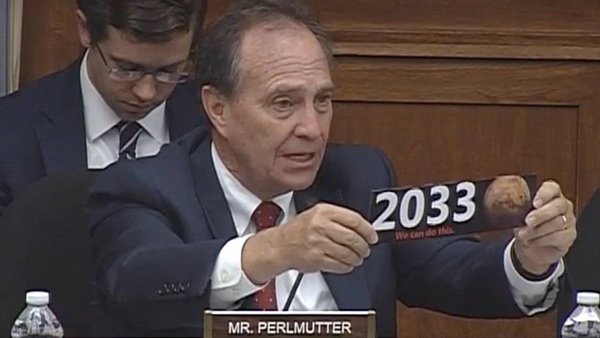 Former Rep. Ed Perlmutter (D-CO) showing off a bumper sticker promoting a 2033 Mars mission at a hearing several years ago. (credit: House Science Committee webcast) |
“An easy way to criticize a flyby is to say, ‘Well, that’s just a stunt. You don’t gain anything from it,’” he said. “That doesn’t look at it in the big picture, which is the flyby is just the first step towards a landing.”
However, just because a mission concept seems feasible or doable doesn’t mean it will be easy. Other panelists at the conference noted that trajectories and launch vehicles aren’t the only things that need to be considered for such a mission.
“I want to get to Mars, and I want to get there as soon as possible,” said Phil Hattis, a fellow at Draper. He was concerned about radiation exposure, both from solar storms and galactic cosmic radiation, as well as the engineering challenges of in-space assembly of all the elements needed for a Mars mission.
“Our biggest concern right now is the food. How are we going to be able to bring enough food for a year and a half or two and a half years, given our engineering status, and make sure that it’s stable and safe and provides the adequate nutrition?” said Jancy McPhee, associate chief scientist of NASA’s Human Research Program. “This is not just a two-week trip where you can eat chicken nuggets and everything’s going to be fine.”
There was no consensus from the discussion whether any of those challenges were insurmountable for a mission launching in a decade or so. McPhee, though, urged caution. “I think we want to get humans to Mars quickly, but we also want to get them back again,” she said. “I think it is worth it to pause a little bit and make sure we’ve done our diligence, to make sure we really think it’s going to be a successful mission.”
Price warned of competition for going to Mars. “I can think of one other country that I think could pull off a 2033 or 2035 flyby mission,” he said, an obvious reference to China, whose government has not publicly talked about a human Mars mission in that time frame.
SpaceX, of course, has also talked about sending humans to Mars—to land rather than orbit or flyby—on similar or earlier timescales, with the usual caveats about schedules. “I wish them the best of luck,” Price said. “It’s not beyond the realm of possibility that a private company could send humans to Mars before NASA or other international space agencies.”
NASA has not indicated any interest in a human Mars mission of any kind in that 2033 opportunity. NASA administrator Bill Nelson has stated several times that the agency could be ready to send humans to Mars around 2039.
Even that might be stretching it. During another panel at the Humans to Mars Summit, agency leaders were cautious when asked if a human Mars landing by 2040 was feasible. “We’re very supportive of doing it,” Nicola Fox, associate administrator for science, said. “I think that would be a bit ambitious.”
| “I think we want to get humans to Mars quickly, but we also want to get them back again,” McPhee said. “I think it is worth it to pause a little bit and make sure we’ve done our diligence, to make sure we really think it’s going to be a successful mission.” |
“That is going to be tough,” said Jim Free, associate administrator for exploration systems development. A landing at the end of the 2030s would require launches as early as 2032 to start prepositioning elements needed for the mission, he said. “It absolutely is aggressive to do that.”
“That is an audacious goal,” added Jim Reuter, associate administrator for space technology.
There is also no longer a congressional backer for an early human Mars mission. Ed Perlmutter retired from Congress at the end of last year, and no one on Capitol Hill has, so far, taken up the mantle or waved the bumper sticker calling for humans to Mars in 2033.
Advocates were undeterred. “I don’t want to make it sound like it’s easy,” Price said. “A 2033 orbit-only or flyby mission could be feasible, and there could be fallback options if the schedule couldn’t be met. But it would be a very bold mission to pull off.”
The panel’s moderator, Beth Mund, even suggested a new bumper sticker: “2035: totally doable.”
Jeff Foust (jeff@thespacereview.com) is the editor and publisher of The Space Review, and a senior staff writer with SpaceNews. He also operates the Spacetoday.net web site. Views and opinions expressed in this article are those of the author alone.
Monday, June 12, 2023
Sunday, June 11, 2023
Saturday, June 10, 2023
Friday, June 9, 2023
Thursday, June 8, 2023
Wednesday, June 7, 2023
Tuesday, June 6, 2023
When The Soviet Union Attempted To Knock Out Reagan's Star Was Program
Barbarian in space: the secret space-laser battle station of the Cold War
by Dwayne A. Day and Robert Kennedy
Monday, June 5, 2023
The night skies over Kazakhstan lit up on May 15, 1987 as a powerful rocket roared off its pad at the Soviet launch complex at Baikonur. The Energia launch vehicle consisted of a core stage with four engines and four liquid-fueled strap-on booster rockets. A long cylinder mounted on the side of the rocket contained the payload, a massive spacecraft with “Polyus,” or “pole”—as in north or south pole—painted in Russian on its side, and “Mir-2” painted on its front. “Mir” means “peace” in Russian, a name that was possibly advertising, a cover story, or an ironic joke.
The spacecraft’s secret name was “Skif,” which referred to the Scythians, an ancient warrior tribe in central Asia—and the European equivalent of “barbarian.” It was the name the program had used for years.
Skif was certainly not peaceful. It contained prototype systems for a powerful orbiting laser intended to burn American satellites out of the sky.
Skif and Kaskad
Asif Siddiqi, a historian at Fordham University who has written extensively about the Soviet space program, explained that Skif dated from mid-1970s space weapons studies which focused on systems to attack satellites in space, ballistic missiles in flight, and ground targets. Two anti-satellite weapon concepts emerged from these studies: Skif and Kaskad (“Cascade”). Skif would be an orbital station using a laser to target lower orbiting satellites, and Kaskad would use missiles to attack satellites in medium and geostationary orbits. The Soviet Union already had an operational ASAT system, but it was limited, and Skif and Kaskad would be far more capable.
| Skif was certainly not peaceful. It contained prototype systems for a powerful orbiting laser intended to burn American satellites out of the sky. |
Although some details about these concepts leaked out in the mid-1990s, it was not until the 2000s, says Siddiqi, that the full extent of the programs finally became known, even in Russia. A former press officer in the Russian space industry, Konstantin Lantratov, pieced together the history of Skif. “Lantratov managed to dig deep into the story, and his research clearly shows the enormous scale of these battle station projects,” Siddiqi says. “These were not sideline efforts—this was a real space weapons program.” In the past decade, even more information on Skif has emerged.
Design work began in the 1970s, not long after the symbolic 1975 Apollo-Soyuz “handshake in space” between NASA astronauts and Russian cosmonauts, and while the two countries were negotiating future cooperation, such as a space shuttle visit to a Salyut space station. The famed Energia organization, which had built the Salyut space stations as well as the ill-fated N-1 moon rocket, a giant that exploded four times between 1969 and 1972, started studying both the Skif and Kaskad ASAT concepts in 1976.
The Salyut space stations, the first of which was launched in 1971, would serve as the core for both the laser-equipped Skif spacecraft and the missile-armed Kaskad. Both would be launched by the workhorse Proton rocket. The Salyut-based weapons stations could be refueled in orbit and could house a crew of two. Skif and Kaskad remained study projects into the early 1980s. But that’s when international politics changed, and made new space weapons more attractive to the Soviet leadership.
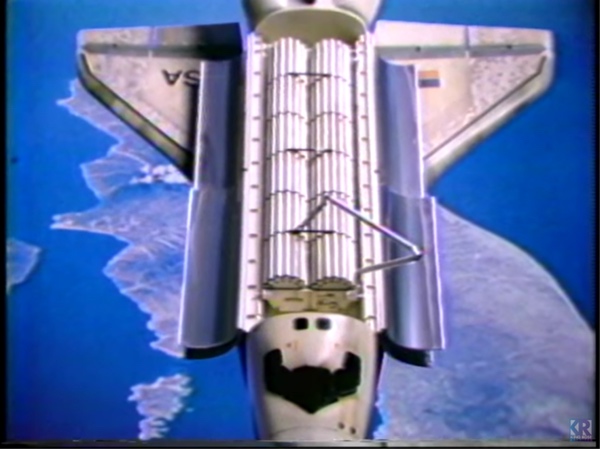 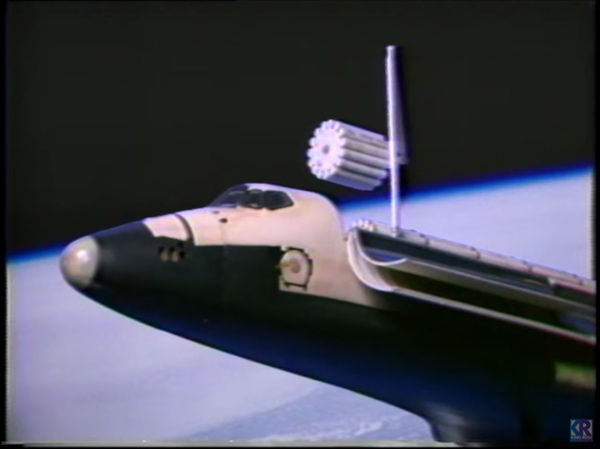  Stills from an animated video produced around 1980 proposing a constellation of orbiting missile launchers for destroying Soviet ICBMs in flight. This concept was rejected in favor of directed energy weapons when Ronald Reagan approved the Strategic Defense Initiative in 1983. Later, after directed energy weapons proved difficult to develop, SDI focused on the "Brilliant Pebbles" concept that was similar to this one. |
The quest for an anti-ballistic missile shield
Although the United States had spent considerable amounts of money in the 1950s and 1960s trying to develop a missile defense system, the difficulty of the task proved too daunting. In 1972, the United States and Soviet Union signed the Anti-Ballistic Missile (ABM) Treaty, which forbade the deployment of new anti-missile systems. The United States completed a single system in Grand Forks, North Dakota, and immediately shut it down. The Soviets had a limited system surrounding Moscow.
Some Soviet military leaders believed that the Americans would nevertheless develop a new ABM system despite the treaty. But after signing the ABM Treaty, the United States largely gave up on ABM technology development. By the mid-1970s ABM development was coming to a halt, with decreasing funding, and progress on anti-missile systems was minimal during President Jimmy Carter’s administration.
The ABM Treaty only forbade the deployment of anti-missile weapons—it did not prohibit testing or development (with some caveats), a loophole both sides exploited. In the United States, some former military and government officials began advocating for space-based anti-missile defenses involving orbiting interceptor weapons (see “Forces of darkness and light,” The Space Review, December 10, 2018.)
 In 1982, a non-government group attached to the Heritage Foundation produced a report advocating for space-based missile defense. (credit: Heritage Foundation) |
Around 1981, when Ronald Reagan took office, scientists at the Lawrence Livermore National Laboratory in California (among them physicist Edward Teller, the so-called “father of the H-bomb”), along with researchers at other federal labs and a handful of military and civilian policymakers, began looking at “directed energy” weapons—which shoot beams instead of bullets—as a way to neutralize an increasing Soviet advantage in launchers and missiles. A space activist even publicly advocated this approach in a 1981 article titled “Lase the Nukes.” In American national security circles, directed energy weapons soon began to eclipse the concept of orbiting interceptor missiles.
Reagan liked the idea, and in a televised speech on national security in March 1983, he announced his plan to build a “defensive shield” to “make nuclear weapons obsolete,” essentially changing the nation’s strategic posture from offense to defense. The proposal was immediately attacked by Democrats in Congress, who called it unworkable, and Senator Ted Kennedy who tagged it with the moniker “Star Wars.” Despite the skeptics, funding for missile defense increased dramatically, amounting to nearly $3 billion a year by 1986.
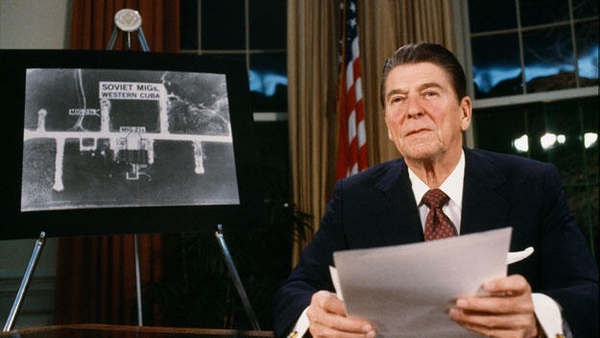 President Ronald Reagan delivered a speech from the Oval Office in March 1983 announcing what became the Strategic Defense Initiative. |
At the time, Allen Thomson was a senior analyst working for the CIA’s Office of Scientific and Weapons Research. He had studied other Soviet military research programs, including efforts to develop directed energy weapons and sensors for space-based submarine detection. In the summer after Reagan’s Star Wars speech, Undersecretary of Defense Fred Iklé requested a CIA study on how the Soviets might respond. The work fell to Thomson and two other analysts.
“The resulting study,” he recalls, “basically said that both politically and technically, the Soviets had a very wide range of options for responding to foreseeable U.S. SDI developments.” They could build more ICBMs, seek to thwart the American missile shield, or try to drum up international opposition to the American plan. “There was some recognition that the USSR might be financially strapped if it had to initiate new major weapons systems. But there was no indication that it would be unable to respond,” Thomson says.
Notably, the Soviet Union did not respond to the American SDI program with a space-based anti-missile program of their own. Bart Hendrickx points out that the Soviets did consider an orbiting ABM system similar to an American program of the late 1980s known as Brilliant Pebbles, but they rejected the concept. “It looks like the Russians concluded well before the start of SDI that a space-based missile shield was unrealistic… and unaffordable as well,” Hendrickx explained. This conclusion created problems for the Soviet leadership. Why did the Americans pursue a space-based anti-missile shield that Soviet scientists and engineers believed was impossible?
As the prominent planetary scientist and Mikhail Gorbachev advisor Roald Sagdeev wrote in his 1994 memoir The Making of a Soviet Scientist, “If Americans oversold [the Strategic Defense Initiative], we Russians overbought it.”
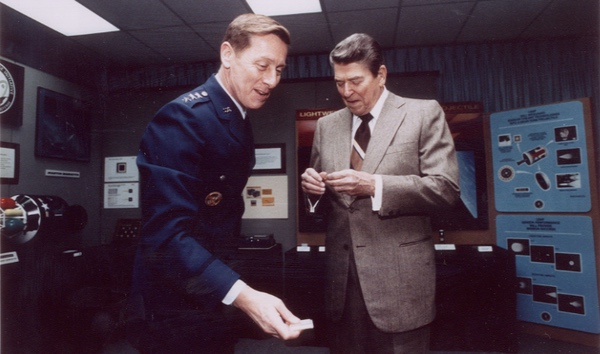 Lieutenant General James Abrahamson, who ran the SDI program showing President Ronald Reagan projects to protect SDI satellites from attack. (credit: Wikimedia Commons) |
Misread intentions
From the perspective of many Soviet scientists and military and political leaders, for the second time in a little over a decade the Americans seemed to be pursuing a nonsensical space program, and Soviet military and political leaders sought to make sense of it. Their conclusions were not always rational. Paranoid fantasies weren’t uncommon among senior Soviet generals, according to Peter Westwick, a history professor at the University of California at Santa Barbara who has written about science during the Cold War. “They thought that maybe the [US] space shuttle was going to be doing shallow dives into the atmosphere and deploying hydrogen bombs,” he says (see “Target Moscow: Soviet suspicions about the military use of the American Space Shuttle (part 1),” The Space Review, January 27, 2020, and part 2, February 3, 2020.)
| “The shuttle really scared the Soviets big-time because they couldn’t figure why you would need a vehicle like that, one that made no economic sense,” Siddiqi explains. “So they figured that there must be some unstated military rationale for the vehicle.” |
Asif Siddiqi agrees that the Soviets misinterpreted US intentions for the space shuttle: “To the Soviets, the shuttle was the big thing. It was a sign to them that the Americans were about to move war into space.” Never mind the official explanation—that the spaceplane, which made its debut in 1981, was meant to provide routine access to orbit. It could also be used to launch classified satellites for US defense agencies.
“The shuttle really scared the Soviets big-time because they couldn’t figure why you would need a vehicle like that, one that made no economic sense,” Siddiqi explains. “So they figured that there must be some unstated military rationale for the vehicle, for example, to deliver and recover large space-based weapons platforms, or to bomb Moscow.” The Soviets responded to the perceived threat by building their own space shuttle, Buran, which ended up being retired in 1993 after just one flight.
Shortly after Reagan’s speech, the Soviet Academy of Sciences was asked to assess whether a space-based missile shield was feasible. Evgeny Velikhov, a prominent physicist, led the study group. Their conclusion, according to Westwick, was, “We looked at it, we studied it, we determined that it wouldn’t work.” But other Soviet scientists were more alarmist, and succeeded in convincing military and political leaders that even if the SDI wasn’t an effective missile shield, it could be used offensively to hit targets on the ground.
The idea of lasers shooting down at Soviet territory from orbit was truly terrifying. According to Westwick, the theories that floated through the Kremlin about the real purpose of the SDI got batty: “Selective political assassination. Say the Politburo is standing outside on May Day and a single laser could take them all out… These things are overhead, they’re invisible, but with zero warning they could zap you.”
 President Ronald Reagan announced his Strategic Defense Initiative program in March 1983. The proponents for the Skif weapons system used this announcement to gain approval for Skif development. Skif was intended to shoot down American SDI satellites from orbit. |
Skif shifts into high gear
In 1981, the KB Salyut design bureau had been transferred to Energia from Chelomei’s design bureau. Skif and Kaskad were already underway at Energia, which was also developing a space shuttle and a large rocket to put it in orbit. Now that KB Salyut was part of Energia, the Skif and Kaskad projects were shifted internally to KB Salyut. (In 1993 KB Salyut became part of Khrunichev.)
Reagan’s 1983 SDI announcement was an instant kick in the pants for the Soviet space weapons program, giving bureaucrats in the aerospace design bureaus the political ammunition they needed to convince the Politburo to increase funding for Skif and Kaskad, which could be used to target the space-based elements of Reagan’s missile shield. Skif and Kaskad would be capable of going after American orbiting anti-ballistic missile satellites. “These were just two of a plethora of ASAT systems that the USSR worked on in the 1980s,” Hendrickx explained, and other ASAT weapons were also proposed to attack SDI satellites. In 2016 he published a paper in the Journal of the British Interplanetary Society outlining the many Soviet anti-satellite programs of that era titled “Naryad-V and the Soviet Anti-Satellite Fleet.”
The rubles started flowing for actual flight hardware, but Kaskad never left the drawing board. Skif, however, shifted into high gear. Soviet engineers working on Skif now found themselves like the dog that finally catches the car—what does he do with it? Skif was going to be an incredibly complicated spacecraft. According to a 2015 Russian space encyclopedia with new information on Skif:
In the course of the work [engineers] had to face significant technical difficulties. So, for example, all the “regular” target equipment (laser and supporting and control systems) existed only in the form of “mock-ups,” [or] at best - experimental ground samples. All electrical systems had to be created from scratch, because the requirements for speed and accuracy were an order of magnitude, or even two, higher than for the systems that existed at that time. The main developers were clearly not ready to create such a complex spacecraft. Over time, the understanding came that the creation of such complexes must begin with the solution of simpler fundamental tasks.
According to the 2015 encyclopedia, the original plan had been to use a “continuous-wave gas laser” built by NPO Energomash, whose core business was the production of powerful liquid-fuel rocket engines. Presumably, this was a hydrogen fluoride laser, the only type of laser that Energomash worked on, drawing from its experience in developing fluorine-based rocket engines. A history of Energomash published in 2004 said it had done its laser work as a subcontractor to NPO Astrofizika, a major Soviet laser design bureau that most likely was the prime contractor for the Skif laser.
However, the hydrogen fluoride laser turned out to be too complex, and it was abandoned in favor of two alternatives. One was a CO2 laser developed for a system called “Dreif,” a nautical term meaning “drift” or “drifting.” Dreif was originally designed to be mounted in a modified Il-76MD cargo aircraft to shoot down American reconnaissance balloons. “Dreif” was also a term applied to balloons drifting across the sky, hence its use for the airborne anti-balloon program. The laser for Skif was apparently developed by NPO Astrofizika with KMZ Soyuz serving as a subcontractor.
Another option was a laser developed by the Central Design Bureau of Chemical Automatics (KBKhA), which also manufactured rocket engines. Sources disagree on some of the details, such as whether it was a CO or CO2 laser, although it was probably CO2, like Dreif.
| Skif-D grew into a Frankenstein’s monster of a spacecraft: 40 meters long, more than 4 meters in diameter, and weighing 95 metric tons, more massive than NASA’s Skylab space station. |
According to the encyclopedia of Soviet and Russian space systems, the plan was to fly both of these lasers on a Skif demonstration mission, with the Dreif laser as the main one, and KBKhA’s as an “auxiliary laser.” The two-laser combination was too heavy for a Proton rocket and was apparently the reason why designers switched to the much more powerful Energia. The need to operate the Dreif laser both automatically and in a space environment prompted substantial redesign. It also required the construction of extensive testing infrastructure.
In August 1984, the new spacecraft was approved and designated “Skif-D,” with the “D” standing for “demonstration.” This approval came only from the Ministry of General Machine Building, which oversaw the space and missile industry, and approval from the Central Committee of the Communist Party did not come until January 1986.
Meanwhile, US scientists and engineers were having their own problems with space-based lasers. As research proceeded on projects like Zenith Star, which investigated the problems of placing a two-megawatt chemical laser in orbit, the challenges of building and launching such systems became clearer. SDI funded studies of particle beams and an X-ray laser that would use a nuclear explosion to set it off, but none of these projects ever came close to being deployed. By 1986, the SDI leadership was already shifting its attention away from lasers and toward small “kinetic kill vehicles” that could bring down enemy missiles by crashing into them—a more conventional interceptor concept that had predated Reagan’s 1983 speech.
The American shift from fewer, large satellites with directed energy weapons to many small satellites equipped with interceptor missiles undercut the justification for the Soviet Skif system. The Soviets, though, stayed the course, and kept working on the demonstration version of their space-based laser, with a target launch date of early 1987.
The Energia rocket, named after its design bureau, was being built to carry the new Buran space shuttle into orbit, meaning that two big projects were now directly competing for resources and launch vehicles. Energia could carry 95 tons to space, enough to lift Skif-D. To keep costs down, engineers looked for other existing hardware designs to modify and incorporate, including a so-called “functional block,” the main section of the TKS spacecraft, which had originally been designed to carry crews and cargo to the canceled Almaz military space stations and would later also serve as the basis for the add-on modules of the Mir space station (as well as the the Zarya/FGB module of the ISS.) They also borrowed a payload module from the TKS.
Skif-D grew into a Frankenstein’s monster of a spacecraft: 40 meters (131 feet) long, more than 4 meters (13 feet) in diameter, and weighing 95 metric tons (210,000 pounds), more massive than NASA’s Skylab space station. The system consisted of what the Russians called a functional block and a payload module. The functional block—what Americans might refer to as a spacecraft bus—was equipped with small rocket engines to place the vehicle into its final orbit. It also included a power system using solar panels borrowed from the TKS spacecraft. The payload module carried carbon dioxide tanks and two 1.2-megawatt turbogenerators to produce the laser’s power, as well as the heavy rotating turret that pointed the beam. The spacecraft was built long and thin so that it could fit on the side of the Energia, attached to its central fuel tank.
Designing a laser to work in orbit was a major engineering challenge. A handheld laser pointer is a relatively simple, static device, but a big gas-powered laser is like a roaring locomotive. Powerful turbogenerators “pump” the carbon dioxide to the point where its atoms become excited and emit light at a specific wavelength. Not only do the turbogenerators have large moving parts, the gas used in the formation of the laser beam gets very hot and has to be vented. Moving parts and exhaust gases pose problems for spacecraft—particularly one that has to be pointed very precisely—because they induce motion. The Skif engineers developed a system to minimize the force of the expelled gas by sending it through deflector vanes, which they referred to as “trousers.” But the vehicle still required a complex control system to damp out motions caused by the exhaust gases, the turbogenerator, and the moving laser turret. When firing, the entire spacecraft would point at the target, with the turret making fine adjustments.
The system was complicated enough that by 1985 the designers knew they would need more than one launch to test its components. Skif-D1 would prove out the basic spacecraft structure in 1987, while the laser itself wouldn’t fly until Skif-D2 in 1988. Around the same time, another, related spacecraft went into development. Designated Skif-Stilet (“Scythian-Stiletto”), it was to be equipped with another existing, less powerful, infrared laser based on an operational ground system. Skif-Stilet would only be able to blind the optics of enemy satellites, but Skif would have enough energy to destroy them.
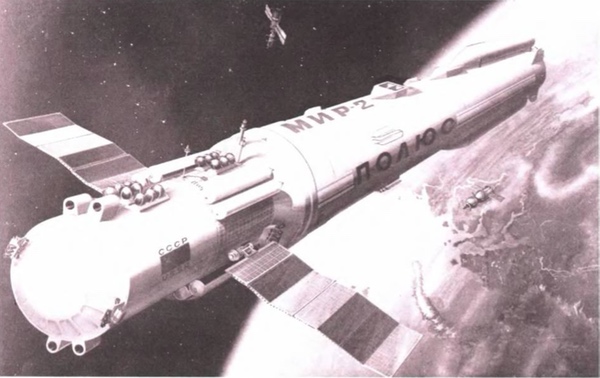 Artist impression of the Skif spacecraft in orbit. The "functional block" containing propulsion, power, and guidance systems, is on the left. The payload module with the lasers is on the right. Also visible at left are the targets that would be deployed and tracked in orbit. |
From Skif-D to Skif-DM
Work on these projects was proceeding at a furious pace throughout 1985 when an unexpected opportunity arose. The Buran shuttle had fallen behind schedule, and wouldn’t be ready in time for the planned first launch of the Energia rocket in 1986. The rocket’s designers were considering launching a dummy Skif payload instead. Launch was scheduled for fall 1986, and the plan was that this would not impact the planned launch of Skif-D1 in summer 1987. According to the encyclopedia, everybody involved in the project did not believe that the 1986 deadline was achievable.
| According to Westwick, Gorbachev began challenging his advisers: “Maybe we shouldn’t be so afraid of SDI.” |
The space encyclopedia states that this change in plans quickly got worse. A week after the announcement about launching a dummy payload, Minister of General Machine Building Oleg Baklanov showed up at KB Salyut and said that just launching a “blank” on the first Energia would not be enough, that they had to demonstrate something more “meaty,” something that would operate for a week in orbit, otherwise it would be “undignified for such a space power as the USSR.” Although those working on the project did not believe they could assemble a “serious” payload in such a short period, work continued. A week later they were told that the payload now had to operate for one month in orbit.
They quickly drew up plans for a vehicle that would test the functional block’s control system and additional components, like the gas ejection vents and a targeting system consisting of a radar and a low-power fine pointing laser that was separate from the big chemical laser. They labeled the spacecraft Skif-DM for “demonstration modification.” It was significantly lighter than Skif-D1, at only 80 metric tons, and did not carry the primary lasers. Despite the orders that the new vehicle not affect the work on the pre-existing planned vehicle, it inevitably led to a slowdown of Skif-D1.
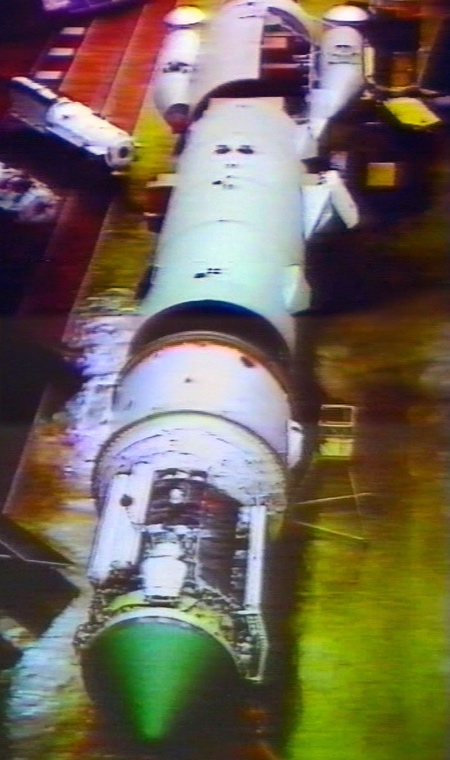 Video screenshot of the Skif-DM spacecraft. The "functional block" is at front, serving as what American space engineers usually refer to as a spacecraft bus. It was adapted from existing space hardware and provided propulsion, power, and guidance in orbit. The lasers would be mounted in the long cylindrical payload module but were not included in the Skif-DM version. During the first and only launch, the functional block was supposed to flip the entire spacecraft 180 degrees so that it was pointed up and the engines were pointed down. However, a software error led to the spacecraft flipping end over end several times before pointing down, and its engines forced it into the atmosphere. (credit: buranarchive.space) |
Racing the clock
Meeting such a tight deadline had a human cost. At one point, more than 70 firms within the Soviet aerospace industry were working on Skif. In his history of the project, Lantratov quotes from an article by Yuri Kornilov, the lead designer for Skif-DM at the Khrunichev Machine Building Factory: “As a rule, no excuses were accepted—not even the fact that it was almost the same group of people who, at that time, were performing the grandiose work associated with the creation of Buran. Everything took a back seat to meeting the deadlines assigned from the top.”
The designers realized that if they launched this huge craft into space, then expelled large amounts of carbon dioxide, American intelligence analysts would quickly figure out that the gas was intended for a laser. So they switched to a combination of xenon and krypton for the Skif-DM venting test. These gases would interact with ionospheric plasma around the Earth, and the spacecraft would appear to be part of a civilian geophysics experiment. Skif-DM would also be equipped with small inflatable balloon targets, mimicking enemy satellites, that would be jettisoned in flight and tracked with the radar and the pointing laser.
The launch of the demonstration satellite slipped to 1987, partly because the pad facility had to be modified from a test stand to a full-up launch pad for the Energia. In addition, the rocket assigned to the flight (designated 6S) had originally only been built for test firings and had to be modified to an operational launch vehicle designated 6SL. The delay had a critical impact on the project’s political fortunes.
In 1986, Mikhail Gorbachev, who had been General Secretary of the Communist Party for only a year, was already advocating the sweeping economic and bureaucratic reforms that would come to be known as perestroika, or “restructuring.” He and his allies in the government were intent on reining in what they saw as ruinous levels of military spending, and had become increasingly opposed to expensive military space projects. According to Westwick, Gorbachev began challenging his advisers: “Maybe we shouldn’t be so afraid of SDI.” The Soviet leader acknowledged that the American SDI plan was dangerous, says Westwick, but warned that his country was becoming obsessed with it.
Lantratov originally wrote that in January 1987, with Skif-DM’s launch just weeks away, Gorbachev’s allies in the Politburo pushed through an order limiting what could be done during the demonstration flight. The spacecraft could be launched into orbit, but could not test the gas venting system or deploy any of the tracking targets. The number of experiments was reduced. However, the 2015 encyclopedia claims that the order forbade any experiments at all to prevent the spacecraft from being interpreted as a space weapon.
In February 1987, the Skif-DM was mated to its Energia rocket as the booster lay horizontally inside a vast assembly building at the Baikonur Cosmodrome in Kazakhstan. At the factory in Moscow, technicians had painted “Mir-2” onto the front, facing outward from the launch vehicle. At Baikonur, technicians also painted “Polyus” onto the side of the spacecraft. “Polyus” was a late name for the program, and was intended for public consumption when the spacecraft was in orbit—a cover story for the weapon. Hendrickx notes that the plan at that time was to use Energia to build a follow-on space station after Mir. According to Lantratov, Mir-2 may have been less an attempt to fool foreign spies about the mission’s true purpose than it was an advertisement for the new project they wanted to build.
| The massive spacecraft tumbled end over end for two full revolutions, then stopped with its nose pointing down toward Earth. In the rush to launch such a complicated spacecraft, the designers had missed a tiny software error. |
The big launch vehicle and payload was rolled out to the launch pad in late February and spent three months there undergoing checks. Hendrickx wrote about this in detail in his history of Buran. A late order came down from leadership for several of the targets to be removed while the vehicle was on the pad, but spacecraft engineers pointed out the dangers of interacting with a fueled rocket, and the order was canceled.
If the skies were clear at any point during this time, American reconnaissance satellites certainly photographed the big rocket and maybe even gathered enough detail for American intelligence analysts to read the words on the spacecraft.
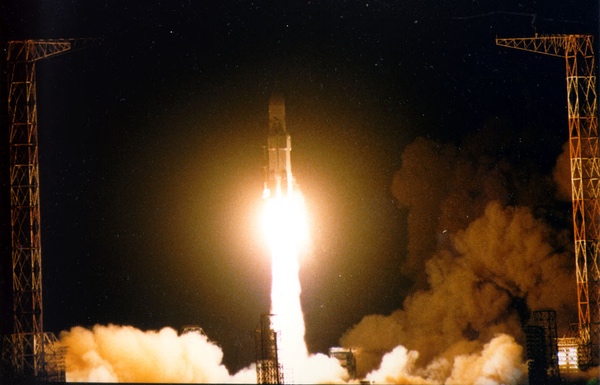 The Skif-DM was launched in May 1987 and failed to reach orbit. It was to be followed by the Skif-D1 and Skif-D2 spacecraft about a year apart. However, the program was canceled after this failure. (credit: buranarchive.space) |
Launching the monster
On the night of May 15, 1987, Energia’s engines lit and the giant rocket climbed into the sky. Whereas most launches from Baikonur head for an orbit inclined 52 degrees to the equator, Skif traveled farther north, on a 65-degree inclination. If the worst happened, this heading would keep rocket stages or pieces of debris—or the Skif-DM itself—from falling on foreign territory. The goal was for a 64.6 degree, 280-kilometer orbit.
The Energia rocket performed flawlessly on its first flight, gaining speed as it rose and arced out toward the northern Pacific. But the kluged nature of the Skif–DM test spacecraft, along with all the compromises and shortcuts, had ordained its doom. The satellite’s functional block had originally been designed for a Proton launcher, where it would be mounted under a payload shroud, so for aerodynamic reasons it was mounted near the top of the payload attached to the Energia. It would jettison its protective shroud before separating from the rocket. Once the spacecraft separated from its booster, it was supposed to flip around to point toward space, with the control block’s engines facing downward toward Earth, ready to fire and push it into orbit. It would also roll 90 degrees as well. Payload fairing separation occurred as planned at 3 minutes and 32 seconds into the flight, at an altitude of 90 kilometers.
After continuing its ascent, Skif-DM separated on cue and the spent Energia fell away. Then the entire 40-meter-long spacecraft began its gentle pitch maneuver. Its tail end—actually the front of the spacecraft—swung up through 90 degrees, through 180 degrees…then kept going. The massive spacecraft tumbled end over end for two full revolutions, then stopped with its nose pointing down toward Earth. In the rush to launch such a complicated spacecraft, the designers had missed a tiny software error. The engines fired, and Skif-DM headed back into the atmosphere it had just escaped, quickly overheating and breaking into burning pieces over the Pacific Ocean. The Soviet press agency TASS reported the loss of a “dummy satellite.”
In the West, the debut of the Energia super-rocket was reported as a partial success, since the launcher itself operated perfectly; it was the satellite that had failed. The US government almost certainly had intelligence sensors pointed at the rocket as it flew, but what the CIA or other agencies concluded about the payload remains classified.
The failure of the Skif program, combined with its immense expense, gave opponents in Gorbachev’s government the ammunition they needed to kill it. Further Skif flights were summarily canceled. Hardware already being prepared on the ground was either scrapped or shoved to the sides of giant warehouses.
In his history of the project, Lantratov quoted Yuri Kornilov, the Skif-DM lead designer: “Of course, no one received any prizes or awards for their feverish, two-year-long, under-the-deadline work. The hundreds of teams that had created Skif were not given an award or a word of thanks.” In fact, some were reprimanded or demoted after the Skif-DM failure.
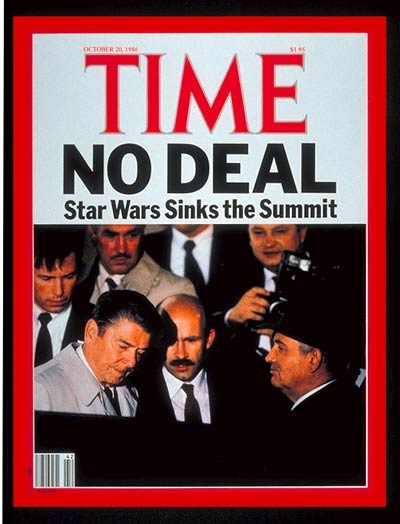 The Strategic Defense Initiative became a contentious topic during arms control negotiations in the 1980s. Many Soviet scientists—like their Western counterparts—believed that it was unworkable. But the official Soviet government position was to oppose SDI. |
Skif’s legacy
We still don’t know the entire story. “Even today there’s a lot of sensitivity about the whole program,” says Siddiqi, who has recently written a paper about how various parts of the Soviet government responded to SDI. “Russians don’t like to talk too much about it. And our understanding of Soviet responses to SDI still remains murky. It’s clear that there was a lot of internal debate within the Soviet military-industrial elite about the effectiveness of space weapons. And the fact that the Soviets came so close to actually launching a weapon platform suggests that the hardliners were in the driver’s seat. It’s scary to think what might have happened if Polyus had actually made it to orbit.”
Another interesting thought experiment is to posit what might have happened had Reagan never announced the SDI, which had derailed arms control negotiations. Would the two leaders have gone further than they did if SDI had not become a point of contention?
| SDI did not help bankrupt the Soviet Union, which was already bankrupting itself. |
CIA analyst Allen Thomson’s 1983 report on possible Soviet responses to SDI accurately predicted several of the actions that the Soviet Union ultimately took, including the Soviet diplomatic offensive against it as well as the possibility that the Soviets would develop systems to attack American SDI satellites. The paranoid fantasies of some Soviet military and political leaders about what SDI could do, such as destroying targets on the ground using lasers, were the kinds of reactions that only became clearer after the end of the Cold War. (The CIA report can be downloaded here.)
Historian Pavel Podvig has tried to determine SDI’s ultimate impact on the Soviet Union and the Cold War. According to a 2017 paper by Podvig, SDI did not deter the Soviet Union from fielding more ICBMs; if they thought that SDI would have worked, they would have shifted their weapons to other systems, like cruise missiles. Skif was already in the works before SDI, and Podvig argues that it was an extension of existing programs rather than a clear response to Reagan’s program. Nevertheless, it failed to reach orbit and there was no follow-on anti-SDI space program, and no clear indication that Soviet weapons or space spending increased as a result of SDI. SDI did not help bankrupt the Soviet Union, which was already bankrupting itself. The Soviet response to SDI was primarily diplomatic and in the realm of arms control rather than military, Podvig wrote.
Skif was an ambitious project, but never accomplished its mission, and was quickly canceled and suppressed, unknown until decades later. Given the current state of Russian politics, it will likely be decades until we can learn even more about this period when the superpowers planned to put weapons in the skies above.
The authors would like to thank Bart Hendrickx and Asif Siddiqi for their extensive help.
Dwayne Day is interested in hearing from an